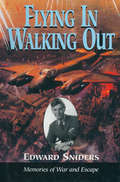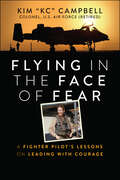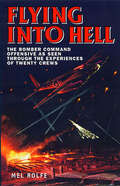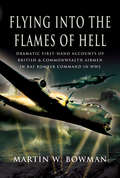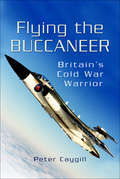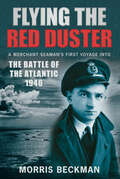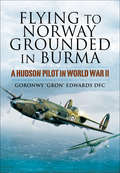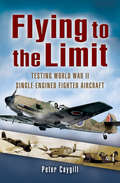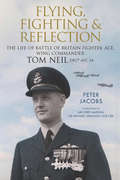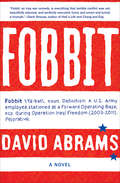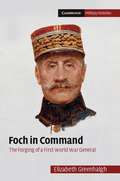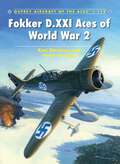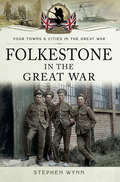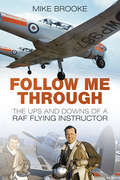- Table View
- List View
Flying in Walking Out: Memories of War and Escape (Soundings Ser.)
by Edward SnidersEdward Sniders'' experiences of World War Two make compelling reading. As a Mosquito pilot, he led a charmed life until his luck ran out in dramatic fashion.'
Flying in the Face of Fear: A Fighter Pilot's Lessons on Leading with Courage
by Kim CampbellProven principles of leadership from a veteran fighter pilot and military leader In Flying in the Face of Fear: Lessons on Leading with Courage, former fighter pilot and retired Air Force Colonel Kim Campbell delivers an inspiring and practical discussion of leadership and decision-making. In the book, you’ll follow the author’s journey through the principles that got her through her 24-year career in the high-stakes and high-risk world of aerial combat. You’ll discover lessons and stories that will serve as a resource for you as you lead your students, employees, and others through the challenges of life and work, learning to create a positive impact and make a big difference in the lives of the people who follow you. You’ll also find: Specific strategies and techniques for leading in situations of extreme stress and risk Methods for female leaders to overcome the challenges of working in male-dominated environments Ways to act in critical moments by recognizing that being brave and afraid at the same time is both normal and necessaryAn essential leadership blueprint for business and military professionals seeking to improve their ability to inspire others to greater achievements, Flying in the Face of Fear will also earn a place in the libraries of young and mid-career professionals looking for mentorship and sound, proven advice.
Flying into Hell: The Bomber Command Offensive as Seen Through the Experiences of Twenty Crews
by Mel RolfeVivid World War II stories of the brave men of Bomber Command and their adventures from the bestselling author of To Hell and Back and Hell on Earth. Mel Rolfe brings the reader real-life stories of bomber command at war with his new book Flying into Hell. A journalist by profession, Rolfe has conducted his interviews and prepared the stories in such a way as to take the reader into the events as they happened. To read these accounts is to step back into the war itself . . . Returning to a French village three years after baling out from a blazing bomber, a former rear gunner was shown the site of his supposed grave. He had been so badly burned a French doctor had left him alone in a graveyard to die. He met again the brave people who had looked after him until he was well enough to join a group walking to freedom across the Pyrenees. Other stories include a bomber that came down so low over the sea to escape ack-ack guns that it struck the water and managed to claw its way back up into the sky; the Lancaster pilot who wore Hermann Goering&’s Iron Cross around his neck as a lucky charm; a gunner incarcerated in Buchenwald; and a flight engineer who lost his fingers to frostbite after the bomber&’s rear door was blown open. Many of these stories demonstrate the amazing resilience of the human spirit, and the unwavering courage of the young men who helped bomb the enemy into submission. They are illustrated with photographs, most of which have not been published before.
Flying into the Flames of Hell: Dramatic First-Hand Accounts of British & Commonwealth Airmen in RAF Bomber Command in WW2
by Martin W. BowmanThe book contains twenty-three stirring accounts of what life flying as air-crew in World War Two was really like. The writers are a mixed bunch of pilots, navigators and gunners who flew medium and heavy bombers or Mosquitoes. It conveys the terror of being coned by German searchlights over the target, attacks by Luftwaffe night-fighters, catastrophic damage to aircraft and the ensuing struggle to keep the machine airborne on the return trip to base. It tells of the comradeship between the crew and often the humor between them which was often bred from fear.The gentle and unassuming narratives convey the sense of purpose that these men felt in doing one of the most dangerous jobs in the war. It is a fitting tribute to those that survived and the many thousands who died in the struggle against Hitler's dreadful ambitions in Europe.
Flying the Buccaneer: Britain's Cold War Warrior
by Peter CaygillOriginally conceived as a carrier-born maritime attack aircraft, the Blackburn design included many original features such as Boundary Layer Control, a system which blew hot air over the flying surfaces to increase lift when landing.
Flying the Red Duster: A Merchant Seaman's First Voyage into the Battle of the Atlantic 1940
by Morris BeckmanFollowing the evacuation of the British Expeditionary Force from Dunkirk in 1940, Britain was at her most vulnerable. France had capitulated and the Germans had control of ports from the Arctic to the Mediterranean. Nazi U-boats were at Britain's doorstep, and in that year alone they sunk 204 ships, a gross tonnage of 2,435,667. Britain stood alone against Germany and a vital lifeline was the supplies carried by the civilian Merchant Navy, defended only by the thinly stretched Royal Navy. Winston Churchill conceded that his greatest fear was the slaughter of merchant seaman, who worked in harsh conditions, were often poorly fed, and were always at the mercy of the Kriegsmarine. In Flying the Red Duster, Morris Beckman tells the story of his experiences as a merchant seaman during the Battle of the Atlantic, part of the civilian force which enabled Britain to avoid capitulation to Nazi Germany. Based on his wartime diary - the unique document now held at the Imperial War Museum - this work allows the reader unique access to a time which is fast slipping from living memory.
Flying to Norway, Grounded in Burma: A Hudson Pilot in World War II
by Goronwy ‘Gron’ EdwardsA Royal Air Force pilot recounts his experiences on the front lines of WWII in both Europe and the Pacific in this fascinating military memoir. In 1936, Goronwy &“Gron&” Edwards joined the Royal Air Force on a Short Service Commission. After gaining his wings, he joined No. 233 General Reconnaissance Squadron and flew the Avro Anson, a hastily modified twin-engine aircraft. He later flew the Lockheed Hudson on reconnaissance patrols along the Norwegian coast. Searching for German capital ships hiding in the Fiords, Edwards also came up against Luftwaffe seaplanes—and won a Distinguished Flying Crossed for his valor during the Norwegian campaign. After becoming short-sighted and night-blind, Edwards was posted to the Navigational School at Cranage in Cheshire before qualifying as a Specialist Armament Officer. In September of 1944, he traveled to Maniur, India, where he became the Armament Officer of No. 221 Group. With the Japanese in retreat the group moved to Burma, where Edwards commanded the RAF advance party.
Flying to the Limit: Testing World War II Single-engined Fighter Aircraft
by Peter CaygillThe author of Javelin from the Cockpit looks at some of the more notable British, German, and American fighters through performance and handling trials. During the years preceding and during WW2, the RAF and the Royal Aircraft Establishment were responsible for the selection and procurement of British military aircraft and also to evaluate their capabilities against captured enemy models whenever possible. During the lend-lease agreement with the USA, the RAF and Fleet Air Arm operated several American designs, each of which was tested to evaluate its potential. This book looks at the key area of fighter aircraft and includes the test results and pilot&’s own first-hand accounts of flying seventeen different models, designed in the UK, America and Germany. The reader will learn of the possibilities of air superiority offered by these types and also their weaknesses. Types included are The Hawker Hurricane, Supermarine Spitfire, Boulton Paul Defiant, Hawker Tempest and Typhoon, Bell Airacobra, Messerschmitt Bf 109, Focke-Wulf Fw 190, Brewster Buffalo, Curtiss Tomahawk, North American Mustang, Grumman Martlet, Republic Thunderbolt, and Vought Corsair. All aircraft that saw a great deal of action throughout the War and which are now part of legend.
Flying, Fighting and Reflection: The Life of Battle of Britain Fighter Ace, Wing Commander Tom Neil DFC* AFC AE
by Peter JacobsThis is the thrilling account of the last remaining Battle of Britain ace fighter pilot, Tom Ginger Neil. Neil was one of an elite band, nicknamed The Few by Winston Churchill, he flew Hurricanes during 141 combat missions in that battle and went on to command the first Spitfire XII squadron during 1942/43 as the RAF went on the offensive in north-west Europe.In this, the only full account of Neil's life to be published in collaboration with his family, we learn how he became a poster boy for the war effort and how he credits his sixth sense for keeping him alive during the Second World War.There was, however, one terrifyingly close brush with death, when in 1940 he had a mid-air collision with another Hurricane. With the rear section of his aircraft gone, the plane was out of control and hurtling to the ground, yet somehow he managed to bail out and miraculously survived with only a minor leg injury.As well as RAF service during the Siege of Malta, Wing Commander Neil, who is now in his late nineties, also served with the Americans during the D-Day landings.During his career, Neil was awarded two Distinguished Flying Crosses for the destruction of at least fourteen enemy aircraft, and was a successful test pilot after the war before commanding a jet fighter-reconnaissance squadron in Egypt's troubled Canal Zone during the 1950s for which he was awarded the Air Force Cross.With contributions from the man himself, this book also looks at his life after the RAF and his career as a successful author. For military buffs and novices alike, it is a must-read account of a true war hero.
Fobbit: A Novel
by David AbramsFobbit \’fä-bit\, noun. Definition: A U.S. soldier stationed at a Forward Operating Base who avoids combat by remaining at the base, esp. during Operation Iraqi Freedom (2003-2011). Pejorative.In the satirical tradition of Catch-22 and M*A*S*H, Fobbit takes us into the chaotic world of Baghdad’s Forward Operating Base Triumph. The Forward Operating base, or FOB, is like the back-office of the battlefield - where people eat and sleep, and where a lot of soldiers have what looks suspiciously like a desk job. Male and female soldiers are trying to find an empty Porta Potty in which to get acquainted, grunts are playing Xbox and watching NASCAR between missions, and a lot of the senior staff are more concerned about getting to the chow hall in time for the Friday night all-you-can-eat seafood special than worrying about little things like military strategy.Darkly humorous and based on the author's own experiences in Iraq, Fobbit is a fantastic debut that shows us a behind-the-scenes portrait of the real Iraq war.
Foch in Command
by Elizabeth GreenhalghFerdinand Foch ended the First World War as Marshal of France and supreme commander of the Allied armies on the Western Front. Foch in Command is a pioneering study of his contribution to the Allied victory. Elizabeth Greenhalgh uses contemporary notebooks, letters and documents from previously under-studied archives to chart how the artillery officer, who had never commanded troops in battle when the war began, learned to fight the enemy, to cope with difficult colleagues and allies, and to manoeuvre through the political minefield of civil-military relations. She offers valuable insights into neglected questions: the contribution of unified command to the Allied victory; the role of a commander's general staff; and the mechanisms of command at corps and army level. She demonstrates how an energetic Foch developed war-winning strategies for a modern industrial war and how political realities contributed to his losing the peace.
Focke-Wulf Fw 190 Aces of the Western Front
by John WealThe Fw 190 was the scourge of Fighter Command from the moment it appeared on the Western Front at Abbeville in August 1941 with II./JG 26. A nimble, speedy and well-armed adversary, the ‘Butcher Bird’ quickly proved superior to all Allied fighters of the time, particularly at medium to low altitude. Led by Experten of the calibre of 'Pips' Priller, Heinz Bar and Walter Oesau, the handful of Fw 190-equipped Jagdgeschwader flew against overwhelming odds, firstly on the Channel coast, and then in direct defence of the Reich when the Jagdflieger took on the might of the USAAF’s Eighth and Ninth Air Forces. This is their story.
Focke-Wulf Fw 190: The Early Years—Operations Over France and Britain (Air War Archive)
by Chris GossAn exploration of the early service of Germany&’s Fw 190, containing a unique collection of rare photos displaying the wide use of this aircraft. Widely regarded as the Luftwaffe&’s finest fighter, the Focke-Wulf Fw 190 first saw service in France in August 1941, immediately proving itself at least the equal of the then-latest Spitfire variant, the Mk.V. In this volume, Chris Goss takes a close look at the aircraft&’s features as well as its early history. There were a number of characteristics which contributed to the Fw 190&’s success. For instance, it was designed as a weapons platform and built to withstand heavy punishment. Another element in the Fw 190&’s construction which added to its durability was its wide-tracked, inwards-retracting landing gear. The Fw 190&’s BMW 801 D-2 radial engine also produced 1,677 horsepower, giving the early Focke-Wulf 190 A-8 a top speed of more than 400 miles per hour—which was considerably faster than the early variant Spitfires. As Goss points out, it was the Spitfires with which the Fw 190 pilots frequently had to contend when in combat over the English Channel, and particularly during the Allied raid on Dieppe in August 1942. The Fw 190&’s weapons capability also saw it used as a fighter-bomber against Allied shipping in the Channel and against the southeastern coasts of England in 1942 in tip-and-runs raids. These fast, low-level attacks proved difficult for the defending RAF squadrons to counter and only one Fw 190 was lost on these operations. In this first of two volumes, Goss examines the aircraft&’s features and early days, showing exactly why it was the workhorse of the Luftwaffe.
Fokker D.XXI Aces of World War 2
by Chris Davey Kari StenmanEntering service with the Dutch air force from early 1938, the aircraft was also built under license in Denmark and Finland. Production was also scheduled to commence in Spain too but Nationalist forces overran the factory before this commenced. The Dutch D.XXIs saw less than a week of action following the German invasion of the west on 10 May 1940, with many of the country's 28 fighters being destroyed on the ground. However, those that survived the initial onslaught inflicted losses on the Luftwaffe, 15 pilots sharing in the destruction of 14 German aircraft (fighters, bombers and transports). By then, however, the D.XXI had found everlasting fame in Finland during the Winter War of 1939-40. Proving itself a real thorn in the side of the Soviets, the fighter, operating in primitive conditions and against vastly superior numbers, Finnish D.XXIs racked up an incredible score against the Red Air Force, and in particular its bomber units. No fewer than ten pilots became aces during this brief, but bloody, campaign, with a similar number claiming four victories and subsequently 'making ace' in later types. The sturdy D.XXI was highly rated by the leading Finnish pilots of the time, boasting a good rate of climb and the ability to break off combat when required thanks to its high speed in a dive. The D.XXI also has the distinction of producing the first 'ace in a single mission' in World War 2, when then 1Lt Jorma Sarvanto shot down six Ilyushin DB-3 bombers on 6 January 1940. After spending a year providing home defence and flying coastal patrols during the early stages of the Continuation War in 1941, all surviving Finnish Fokker D.XXIs were relegated to the reconnaissance role, which they performed through to the end of hostilities in September 1944.
Folding Paper Cranes: An Atomic Memoir
by Leonard BirdThe author seeks to make peace with his past and with a future shadowed by nuclear proliferation.His paper cranes are the poetry and prose of this haunting memoir.
Folkestone in the Great War (Your Towns & Cities in the Great War)
by Stephen WynnFolkestone became one of the most important British towns during the First World War. Through its harbor, an estimated 10 million troops and nurses either departed from or arrived back in England between 1914 and 1919. For those leaving it was, for the most part, to fight on the battlefields of the Western Front. For those returning, it was either because they had been wounded or that they were coming home for some well-earned leave.Because of its geographical location along the south coast, the town was always going to be heavily involved in the course of the war. Shorncliffe camp saw the arrival of Canadian soldiers, infantry who had come to practice in its purpose-built trenches, and cavalry units who put their horses through their paces on its open grounds. As well as this, there was an influx of Belgian refugees who arrived in the town, having escaped the tyranny of an advancing Germany Army. Most stayed for the duration of the war, enjoying the hospitality and friendship of local people who had taken them in with open arms.With the town being a hive of military activity, the people of Folkestone went about their business as best they could. For many this included worrying about the well-being of a loved one who had gone off to fight in the war, hoping that they would remain safe but not knowing if they would ever see them again. It wasn't just on the Western Front, however, that death reared its ugly head. On one occasion it happened in Folkestone, in what has become known as the Tontines Street Air Raid. Seventy-one men, women and children were killed and another ninety-four were injured this German air raid, which took place on 25 May 1917. This book is a poignant testimony to those people as well as the men who didn't make it back
Follow Me Home
by Patrick BishopHigh summer in Helmand Province, Afghanistan.Two young soldiers, Milo and Zac, are on a mission which could really make their names. Their special duties team is to ambush and capture a notorious Taliban leader.The operation has been meticulously planned and set up. But suddenly - all is chaos.The hunters are now the hunted. To reach safety they must make their way through fifty kilometres of hostile territory, with a Taliban captive and a young, frightened woman in tow. Perilous at every turn, the journey is the biggest test any of them has ever faced, and it will change their lives forever.
Follow Me Through: The Ups and Downs of a RAF Flying Instructor
by Mike BrookeFollowing his success as a Cold War Canberra pilot, Mike Brooke was dispatched to become a flying instructor at the Central Flying School in the 1970s. ‘Follow him through’, as he would instruct his trainees, as he experiences the quite literal ups and downs of teaching the Glasgow and Strathclyde Air Squadron. Learn how he battled the diminutive de Havilland Chipmunk in order to teach others how to fly the aircraft, then finally moved to instructing on the Canberra in its many marks. Here Mike takes the reader on a quite often bumpy journey as an instructor of pilots old and new. There are tales of flying, near accidents and less serious incidents that flying these old but still demanding aircraft bring. Following on from his debut book, A Bucket of Sunshine, he continues to use his personal experience to bring aviation to life and prove indispensable for any aviation enthusiast.
Following the Harvest: A Novel
by Fred HarrisFollowing the Harvest is the latest novel by award-winning author Fred Harris, and tells the story of sixteen-year-old Will Haley, who journeys north in the summer of 1943 as a member of a wheat-harvesting crew. As the novel opens, Will excitedly prepares to leave behind his small hometown, family, and Saturday-night get-togethers with his friends down at the soda shop and to set out on the road with a cast of unforgettable harvest crew members. Although he is eager to begin his "moveable adventure," Will worries about taking care of his father, a dangerously heavy drinker, as they work their way north together. Traveling with his father, along with a humpbacked hired hand, a whiny truck driver and his pretty wife, two cousins from Mississippi, and his father's best friend, Will makes his way from Vernon, Oklahoma, to Rhame, North Dakota. Along the way he battles field fires and deadly weather, makes an unexpected visit to a house of ill repute, and takes a wild ride at the Frontier Days rodeo in Cheyenne, among other exploits. Will and the crew members work hard and play hard, but tensions run high as Will's father continues to drink heavily and the other crew members face their own demons and dilemmas. Not everyone will make the return trip to Oklahoma, and when an accident claims a crew member's life. Will is forced to take charge and become mature beyond his years. Set against the rich history and wide-open landscape of the Great Plains, Will Haley's coming- of-age story is both a touching and exhilarating read. His odyssey on the high plains is no less than an American epic.
Food Aid and Human Security (Routledge Research EADI Studies in Development #No. 24)
by Olav Schram Stokke Edward ClayFood aid is historically a major element of development aid to support longer-term development, and the primary response to help countries and peoples in crisis. This examination of food aid focuses in particular on institutional questions.
Food in Wartime Britain: Testimonies from the Kitchen Front (1939–1945) (Routledge Studies in Second World War History)
by Natacha ChevalierBased on deep analysis of Mass Observation wartime diaries, Food in Wartime Britain explores the food experience of the British middle classes in their own words throughout the course of the Second World War. It reveals that, while the food practices of the population were modified by rationing and food scarcity, social class and personal circumstances were key dimensions of the wartime food experience that demand to be taken into account in the historical narrative of the Home Front.
Food in Zones of Conflict: Cross-Disciplinary Perspectives (Anthropology of Food & Nutrition #8)
by Helen Macbeth Paul CollinsonThe availability of food is an especially significant issue in zones of conflict because conflict nearly always impinges on the production and the distribution of food, and causes increased competition for food, land and resources Controlling the production of and access to food can also be used as a weapon by protagonists in conflict. The logistics of supply of food to military personnel operating in conflict zones is another important issue. These themes unite this collection, the chapters of which span different geographic areas. This volume will appeal to scholars in a number of different disciplines, including anthropology, nutrition, political science, development studies and international relations, as well as practitioners working in the private and public sectors, who are currently concerned with food-related issues in the field.
Food, Culture and Identity in Germany's Century of War
by Heather Merle Benbow Heather R. PerryEven in the harsh conditions of total war, food is much more than a daily necessity, however scarce—it is social glue and an identity marker, a form of power and a weapon of war. This collection examines the significance of food and hunger in Germany’s turbulent twentieth century. Food-centered perspectives and experiences “from below” reveal the social, cultural and political consequences of three conflicts that defined the twentieth century: the First and Second World Wars and the ensuing global Cold War. Emerging and established scholars examine the analytical salience of food in the context of twentieth-century Germany while pushing conventional temporal frameworks and disciplinary boundaries. Together, these chapters interrogate the ways in which deeper studies of food culture in Germany can shed new light on old wars.
Fool's Hill
by Richard A. LupoffGENOCIDE - IN THE NAME OF LOVEAcross the planet, only a handful of giant, overcrowded, doomed cities exist - cities like Norcal, where multiple marriages are recommended and drug-taking is encouraged.Across the planet, everyone waits for the reclamation of a lost technology that can save them. Everyone, that is, except for the members of the Order of St Jerome in Norcal. The Order of St Jerome believes in peace, in morality, in two-person marriages and old-fashioned values. The trouble is, in the name of love the Order of St Jerome has decided to sacrifice the Earth...
Fools and Mortals: A Novel
by Bernard CornwellNew York Times bestselling author Bernard Cornwell makes a dramatic departure with this enthralling, action-packed standalone novel that tells the story of the first production of A Midsummer Night's Dream—as related by William Shakespeare’s estranged younger brother.Lord, what fools these mortals be . . .In the heart of Elizabethan England, Richard Shakespeare dreams of a glittering career in one of the London playhouses, a world dominated by his older brother, William. But he is a penniless actor, making ends meet through a combination of a beautiful face, petty theft and a silver tongue. As William’s star rises, Richard’s onetime gratitude is souring and he is sorely tempted to abandon family loyalty.So when a priceless manuscript goes missing, suspicion falls upon Richard, forcing him onto a perilous path through a bawdy and frequently brutal London. Entangled in a high-stakes game of duplicity and betrayal which threatens not only his career and potential fortune, but also the lives of his fellow players, Richard has to call on all he has now learned from the brightest stages and the darkest alleyways of the city. To avoid the gallows, he must play the part of a lifetime . . . .Showcasing the superb storytelling skill that has won Bernard Cornwell international renown, Fools and Mortals is a richly portrayed tour de force that brings to life a vivid world of intricate stagecraft, fierce competition, and consuming ambition.
